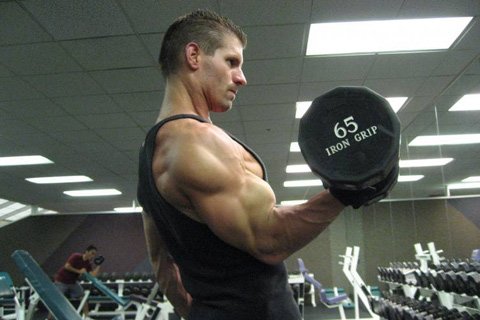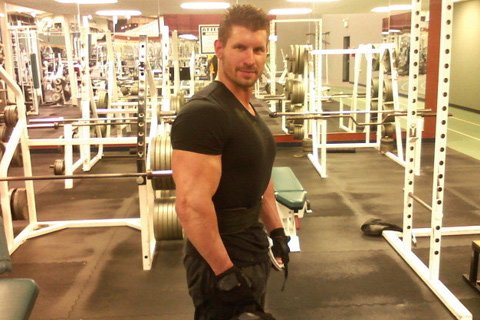We spend a great deal of time practicing training and nutritional strategies that we think will help us best achieve our goals. Rarely do we take the time to step back and analyze the full scheme of exactly what we are doing and why.
Most of the people I see at the gym are there to complete a ritual. By ritual I mean the act of showing up at the gym every day and practicing what ever the individuals workout plan calls for them to do on that particular day.
The Ritual
Some people will tell me they train chest on Monday, arms on Tuesday, legs on Wednesday, back on Thursday, and shoulders on Friday and then take the weekends off. Not to mention, they will perform about 25 sets to failure on each body part they train. That's about 23 more sets to failure then what I do for each muscle group that I train.
I notice these same individuals always going through the motions week after week, month after month, lifting the same weights or even lighter weights then what they could before and their physiques staying mostly the same if not less muscular then what they were before. As time goes on I notice the intensity levels of these individuals diminishing to the point where they appear to be going through their training regimens like spaced out zombies moping from exercise to exercise, grunting and groaning, trying to tap into energy that isn't there.
It kind of reminds me of the movie The Night Of the Living Dead. The zombies in that movie were very persistent trying to get a hold of their victims but then suddenly someone hits them once and they drop like Bret Michaels did when he was clothes-lined by a drop down door on stage at the 2009 Tony Awards! This is what can happen when the stress of overtraining comes to a head.
Keeping A Training Journal
One common denominator that I've noticed among gym members, who follow these training rituals day after day, is that none of them keep a training journal to record anything that they are doing. I can't stress this point enough! You should always bring a journal or notebook with you to the gym and be sure to record everything you do in your workout routines. Write down your exercises, the amount of weight you use, and also the repetitions you were able to perform with each particular weight.
When you go to the doctor for medical check ups or physicals your doctor keeps a chart on you that lists all your vitals and blood values. Each time you return to the doctor he or she will look up your medical records and check to see if there has been any changes in your vitals or blood values from the last time you were into the doctor. Keeping these types of records will help a doctor determine if your health is improving or regressing.
The same holds true for keeping a training journal. Charting is an important way to measure progress. You should write down everything you do during your workout so any time you go to repeat any given workout you can refer back to what you did last time and compare to what you're currently doing and see if you gained strength, lost strength, or just stayed the same as last time.
Hopefully you gain strength each and every time. When your goal is to build more muscle you should be lifting more weight, or doing the same weight for more repetitions on each and every exercise compared to the last time you did that particular workout. If you're seeing that you're not gaining strength each time you repeat any given workout, then you haven't gained more muscle. You don't gain muscle without gaining strength. You don't increase muscle mass by getting weaker. It just doesn't work that way.

 Click To Enlarge.
Click To Enlarge. When Your Goal Is To Build More Muscle You Should Be Lifting More Weight, Or Doing The Same Weight For More Repetitions On Each
And Every Exercise Compared To The Last Time You Did
That Particular Workout.
Science Of Building Muscle
There is a very direct relationship between muscular size and strength. If you should go to repeat any given workout and find that your strength hasn't increased then that means that your muscles haven't had sufficient recovery time for overcompensation or muscle growth to occur. The remedy for this problem is to begin incorporating at least 2 more recovery days between all of your lifting workouts from that point forward. This is where you stop making your training routine a ritual and you start making it a science to produce more muscle growth.
Never repeat a workout just because it's part of a ritual. You should only repeat a workout when you know that your muscles have had sufficient time to recover and produce growth. As I've mentioned in past articles, as you become stronger and more intense, you lift heavier weights, which creates a deeper in-road into the muscles recovery ability.
To compensate for this you must reduce both the volume and frequency of your training to ensure that your body has enough to time to replenish it's very limited resources to recover so that your muscles can over compensate and become larger. When you go back and start tearing on your muscles again too soon, then you short circuit the recovery ability of your body and dig an even deeper road into the muscles' recovery ability and place yourself that much further away from obtaining muscle growth.

 Click To Enlarge.
Click To Enlarge. If You Should Go To Repeat Any Given Workout And Find That Your Strength Hasn't Increased Then That Means That Your Muscles Haven't Had Sufficient Recovery Time.
Rest Makes You Grow!
I know many people will shudder at the notion that you should add in an extra 2 days of recovery time between all lifting workouts when you reach a sticking point. When you look at things realistically, if it takes 7-14 days for a muscle to recover and then over compensate or grow, then how could a muscle shrink from an additional 2 days of recovery time? That can't happen. By increasing your recovery time by a couple days, what you have to lose is nothing, but what you have to gain is the reassurance that the next time you go into the gym to lift that your muscles are fully recovered and you're coming back stronger then you were the last time.
Should you come back too soon, however, you run the risk of cheating yourself out of any strength or muscle gain at all. By digging an even deeper inroad into the muscles' recovery ability before it has had the chance to grow, you are only hurting your results. It's the "more is better" mentality that has been branded in the back of all our minds as a result of decades of misinformation being fed to us by various publications.

 Click To Enlarge.
Click To Enlarge. If You Don't Allow Yourself To Recover Properly You Run The Risk Of Cheating Yourself Out Of Any Strength Or Muscle Gain At All.
I understand from experience that it's hard to change your way of thinking about a certain subject when you've been lead to believe that this one certain path is the only path that will lead you to success because so many have said so. It's tough to instantly change your way of thinking. It's kind of like when your parents finally had to tell you there's not really a Santa Claus or an Easter Bunny. I just found out last year, and I'm still totally furious!
All joking aside, I know how tough it can be to break routines that have been engraved in your mind for so long. I wasted a good 5 years by practicing a training ritual that wasn't getting me anywhere before I decided it was time for a different approach.
I'm not sure what I was thinking. If my routine hadn't produced any meaningful results for weeks or months let alone years, why would it just magically start working out of the blue? This was the turning point where I decided I needed to make my workout routine less of a ritual and more of a science. By making this change I was able to bring my physique to whole new level that I had previously deemed impossible.
Conclusion
If you feel that you have also been following a workout routine as more of ritual, then go out and buy a little notebook to toss in your gym bag, and start treating your training like more of a science and begin charting your workouts to ensure that you're progressing and not regressing.
Become a scientist with your own body and study the evidence in your training journal. You may find evidence that shows you're making good progress or you may find evidence that tells you that you aren't giving your body enough recovery time in which case you need to make the necessary adjustments to begin making progress again.
Additional Workout
Terms You'll Need To Know
Giant Set: Four or more exercises are performed consecutively without any rest.
Failure That point in an exercise at which you have so fully fatigued your working muscles that they can no longer complete an additional repetition of a movement with strict biomechanics. You should always take your post-warm-up sets at least to the point of momentary muscular failure, and frequently past that point.
Day 1: Biceps/Triceps
Giant Set these 4 exercises all together:
- Double-Arm Dumbbell Preacher Curls (palms-up): 6 full range reps, 3 short-range partial reps (lowering the bar from the contracted position about 3-4 inches)
- Preacher Curls: 6 full range rep, 3 partial reps
- Reverse Preacher Curls: 6 full range reps, 3 partial reps
- Hammer Dumbbell Preacher Curls (palms facing in): 6 full range reps, 3 partial reps
- Triceps Cable Extensions: using a V-shaper grip attached to a high pulley, face away from the pulley kneeling down on floor with a bench sitting lengthwise in front of you, bend forward till your back is parallel to the floor and your elbows are positioned on the bench out in front of your head. Your face will be aiming down towards the floor. Holding the V-handle extend your arms outward till you reach full extension and the triceps contract completely. Perform 2 warm-up sets (not to failure) Then 1 heavy set of 6-10 reps to failure
- Dip Machine or Weighted Dips: 1 set of 8-12 reps to complete failure
Day 2: Cardio
- 20 minutes of HIIT
- Hanging Leg Raises: 1 set to failure
- V-Sit (Jackknife): 1 set to failure
Day 3: Hamstrings/Lower Back
- Deadlifts: 3 warm up sets (not to failure), progressively adding weight on each set. Then 1 heavy set of 6-10 reps to complete failure
- Machine Leg Curls: Do 1-2 warm up sets (not to failure), then 1 heavy set of 8-12 reps to complete failure. Hold weight statically as long as you can on last rep
- Standing Calf Raises: 1 warm up set (not to failure), then 1 set of 12-20 reps to complete failure with feet shoulder width apart and toes pointed forward, then 10 second rest pause and widen stance with toes pointed slightly outward and go to failure, then another 10 second rest pause and bring feet in together with toes pointed slightly inward and push to complete failure
Day 4: Cardio
- 20 minutes of HIIT
- Hanging Leg Raises: 1 set to failure
- V-Sit (Jackknife): 1 set to failure
Day 5: Shoulders
- Shoulder Press (Machine or Free weight): Perform 2 warm up sets (not to failure), progressively adding weight on each set. Then 1 heavy set of 6-10 reps to complete failure
- Side Lateral Raise (Delt Machine): Perform 1 warm up set (not to failure), Then do 1 heavy set of 6-10 reps to complete failure, 10 second rest pause, drop weight 10-20%, push to failure, 10 second rest pause, drop weight 10-20%, then push to complete failure
- Reverse Flyes: I like to use cable crossover machine, kriss-crossing my arms, and grasping the handles from the top cable pulley's and pulling the handles from the top, bringing my hands down and outward behind my body as I squeeze the rear delts. You may use Dumbbells if that works easier. Perform 1 warm up set (not to failure), Then do 1 heavy set of 6-10 reps to complete failure, 10 second rest pause, drop weight 10-20%, push to failure, 10 second rest pause, drop weight 10-20%, then push to complete failure
- Dumbbell Shrug: Perform 1 warm up set (not to failure), then 1 heavy set of 8-12 reps to complete failure
Day 6: Cardio
- 20 minutes of HIIT
- Hanging Leg Raises: 1 set to failure
- V-Sit (Jackknife): 1 set to failure
Day 7: Rest
Day 8: Quadriceps
- Smith Machine Squats: 3 warm-up sets (not to failure), progressively adding weight on each set. Then 1 heavy set of 8-12 reps to complete failure.
- Leg Press: 1-2 warm-up sets (not to failure), then 1 heavy set of 8-12 reps to complete failure
- Leg Extensions: 1 warm-up set (not to failure), then 1 set of 8-15 reps to complete failure, then lower weight 10-20% and perform 10 second rest pause and go to failure, then lower weight another 10-20% and go to failure. On very last rep, hold weight statically as long as you can
- Standing Calf Raises: 1 warm-up set (not to failure), then 1 set of 12-20 reps to complete failure with feet shoulder width apart and toes pointed forward, then 10 second rest pause and widen stance with toes pointed slightly outward and go to failure, then another 10 second rest pause and bring feet in together with toes pointed slightly inward and push to complete failure
Day 9: Cardio
- 20 minutes of HIIT
- Hanging Leg Raises: 1 set to failure
- V-Sit (Jackknife): 1 set to failure
Day 10: Chest
- Flat Dumbbell Press or Bench Press: 3 warm-up sets (not to failure), progressively adding weight on each set. Then 1 heavy set of 6-10 reps to complete failure
- Smith machine Inclined Bench Press: Perform 1 warm-up set (not to failure), Then do 1 heavy set of 6-10 reps to complete failure, 10 second rest pause, drop weight 10-20%, push to failure, 10 second rest pause, drop weight 10-20%, then push to complete failure
- Cable Cross-Over or Butterfly: 1 warm up set (not to failure), then 1 set of 8-12 reps to complete failure. Hold weight statically as long as you can on last rep
Day 11: Cardio
- 20 minutes of HIIT
- Hanging Leg Raises: 1 set to failure
- V-Sit (Jackknife): 1 set to failure
Day 12: Back
- T-Bar Rows or Barbell Rows: 3 warm-up sets (not to failure), progressively adding weight on each set. Then 1 heavy set of 8-12 reps to complete failure
- Narrow, Reverse-Grip, Lat Pull-Down: Perform 1 warm up set (not to failure), Then do 1 heavy set of 6-10 reps to complete failure, 10 second rest pause, drop weight 10-20%, push to failure, 10 second rest pause, drop weight 10-20%, then push to complete failure.
- Seated Cable Rows: Do 1 warm-up set (not to failure), then 1 heavy set of 8-12 reps to complete failure. Hold weight statically as long as you can on last rep
- Dumbbell Pull-Over: 1 warm up set (not to failure), then 1 set of 8-12 reps to complete failure
Day 13: Cardio
- 20 minutes of HIIT
- Hanging Leg Raises: 1 set to failure
- V-Sit (Jackknife): 1 set to failure
Day 14: Rest
Day 15: Repeat Cycle, Go back to Day 1 Workout.

